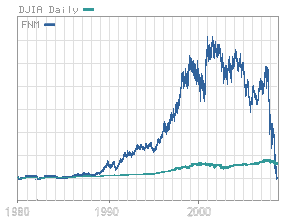In 1968, to remove the activity of Fannie Mae from the annual balance sheet of the federal budget, it was converted into a private corporation. Fannie Mae ceased to be the guarantor of government-issued mortgages, and that responsibility was transferred to the new Government National Mortgage Association (Ginnie Mae). In 1995, Fannie Mae began receiving affordable housing credit for buying subprime securities. In 1999, the Clinton administration and Fannie Mae shareholders encouraged the lender to increase the number of mortgage loans offered to those of low and moderate income, both to improve rates of home ownership among those groups and to increase profits.
In 2000, due to a re-assessment of the housing market by HUD, anti-predatory lending rules were put into place that disallowed risky, high-cost loans from being credited toward affordable housing goals. In 2004, these rules were dropped and high-risk loans were again counted toward affordable housing goals.
Fannie Mae was put under a conservatorship of the U.S. Federal government on September 7, 2008.
Fannie, a government-sponsored company, had long helped Americans get cheaper home loans by serving as a powerful middleman, buying mortgages from lenders and banks and then holding or reselling them to Wall Street investors. This allowed banks to make even more loans — expanding the pool of homeowners and permitting Fannie to ring up handsome profits along the way.
But by the time Mr. Mudd became Fannie’s chief executive in 2004, his company was under siege. Competitors were snatching lucrative parts of its business. Congress was demanding that Mr. Mudd help steer more loans to low-income borrowers. Lenders were threatening to sell directly to Wall Street unless Fannie bought a bigger chunk of their riskiest loans.
So Mr. Mudd made a fateful choice. Disregarding warnings from his managers that lenders were making too many loans that would never be repaid, he steered Fannie into more treacherous corners of the mortgage market, according to executives.
For a time, that decision proved profitable. In the end, it nearly destroyed the company and threatened to drag down the housing market and the economy.

This article in today’s New York Times is, perhaps, the most deeply disquieting report yet about the roots of the financial crisis. It’s a story of people bowing to pressures from inside and outside the government to do things should never have even been considered. Fannie Mae and Freddy Mac occupied a unique position as former governmental institutions that were neither private nor public. They were positioned such that they were somewhat regulated, but it seems that, in their internal workings, they were on their own. The long and short of things is that they bought increasingly risky loans, exceeding their capacity to ever cover them if the housing bubble burst [or should I say "when"the housing bubble burst"].
When C.E.O. Daniel Mudd [son of news-guy Roger] says "Almost no one expected what was coming…" in his defense, he should be saying "Almost no one who was making money hand over fist from the housing bubble expected what was coming…" There were more than enough economists who were saying it, and saying it…
Sorry, the comment form is closed at this time.